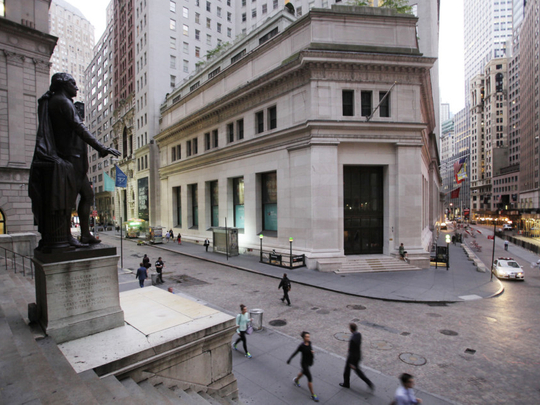
For the past several months, ever since the election, chief executives of the US’s largest companies have repeatedly professed to be more confident than ever. They say, in survey after survey, that they are more optimistic about the economy and their own businesses, waxing about the prospect of lower regulations and lower taxes under President Donald Trump and a Republican-controlled Congress.
Investors, at the same time, have bid up the stock market.
Yet there is a remarkable divergence between what chief executives have been saying aloud and what they are actually doing in practice. They may not be as confident as they say they are.
On Wall Street, there is one barometer that is considered the ultimate truth serum when it comes to reflecting CEO confidence: merger and acquisition activity.
Corporate chieftains do deals when they are confident about their own business and the trends in the economy. When they are nervous about the future, they usually pull back from deal-making and focus inward.
If you can’t remember reading about a big deal announced recently, that’s because there hasn’t been one. The reality is that since Trump was elected, mergers have fallen off a cliff.
The numbers tell the story: So far this year, the number of deals and their size are at the lowest level since 2013. Total deal-making in the US in the first quarter was off nearly 40 per cent from its peak during the same period in 2015, according to S&P Global Market Intelligence.
And yet, the Business Roundtable, which conducts a survey of chief executives, said its confidence index “jumped 19.1 points, from 74.2 in the fourth quarter of last year to 93.3 in the current quarter,” well above the historical average of 79.8.
How to make sense of the disconnect?
“CEO and consumer confidence is clearly up,’’ said John Waldron, co-head of global investment banking at Goldman Sachs. “But management teams and boards seem to be waiting this out,” especially on mega-transactions. He cited “uncertainty around Trump policies being enacted,” ticking off “taxes, infrastructure, deregulation,” as well as a view that despite the headlines, “regulatory scrutiny hasn’t abated yet.”
He also said that some companies worry about a backlash from the Trump administration if a deal were to rely on “synergies” — a euphemism for layoffs — to make the numbers work.
Yes, the prospect of an early morning Twitter tirade from Trump may be holding back deal-making. And that’s not confidence inducing.
None of this is meant to suggest that chief executives don’t genuinely feel more optimistic; they probably do. Maybe it requires a bit of an armchair psychological diagnosis, but that optimism has yet to manifest itself in its most visible form: big acquisitions.
In an admittedly unscientific survey of more than a dozen chief executives, bankers and lawyers — who work for some of the nation’s largest companies and maintain a pipeline of potential deals — told me that while mega-transactions have slowed, they were hopeful that the current sense of optimism would translate into more deal-making.
“For mergers and acquisitions to do well requires the first two years after closing a transaction to give you an economic tail wind, not a headwind,’’ said Blair Effron, chief executive of Centerview Partners, a boutique investment bank that has worked on some of the largest transactions of the last several years. “And that’s the question mark right now.”
Effron pointed out that it isn’t just merger activity that has trailed off. Companies have also slowed buy-backs of their shares — a practice I have long argued is too often used as a financial engineering manoeuvre to increase earnings per share and compensation based on such metrics. But it also suggests that companies are less confident in their future stock prices than they once were.
Perhaps that is simply a reflection of the fact that stock prices are already so high, but it may also say something about executives’ true feelings about the state of the economy.
“If people think we’re going to be in a good place in the next two years, you’ll see transaction activity pick up,’’ Effron said, noting that the growth rate hasn’t actually changed much in the last five years.
Surprisingly, deal-making outside the US is up, according to S&P Global Market Intelligence. Even with all the geopolitical risks and Britain’s decision to leave the European Union, deal-making in Europe, for example, has increased by 23 per cent in the first quarter of the year.
Tobias Levkovich, chief US equity strategist at Citigroup, has a more dire view of what the lack of deal-making means here at home: He’s worried it portends a potential pullback in the stock market.
He sent his clients a chart overlaying merger activity and the stock market. It showed that merger activity is often a good forward indicator of the stock market — and right now the lines are out of whack given that the market is up and mergers are down.
“In some respects, one of the scariest charts to look at currently is the number of announced mergers and acquisition deals over the past year or two,” Levkovich wrote in a note.
He continued: “M&A lawyers argue the uncertainty factor, which has come about recently, given some unpredictable aspects of the new Trump administration, has been the issue.’’
But Levkovich said he also thought it may say something more profound about the possibility of an overvalued stock market. “It only may explain the last six months, but the trend has been poor for about two years or more,’’ he said.
Perhaps we will look back on this moment as the calm before a storm of more deals. But in the meantime, the next time a chief executive says he or she is more confident ever, remember the adage: Watch what they do, not what they say.
— New York Times News Service












